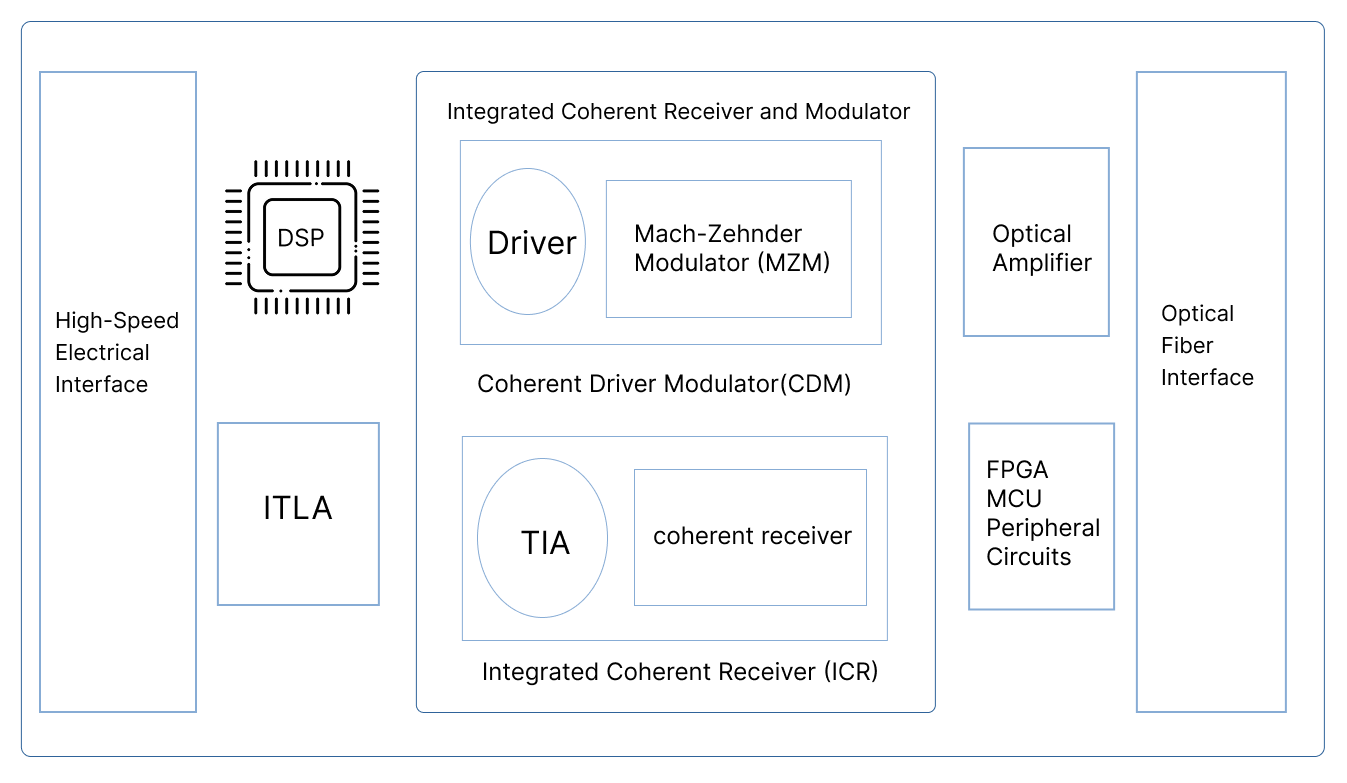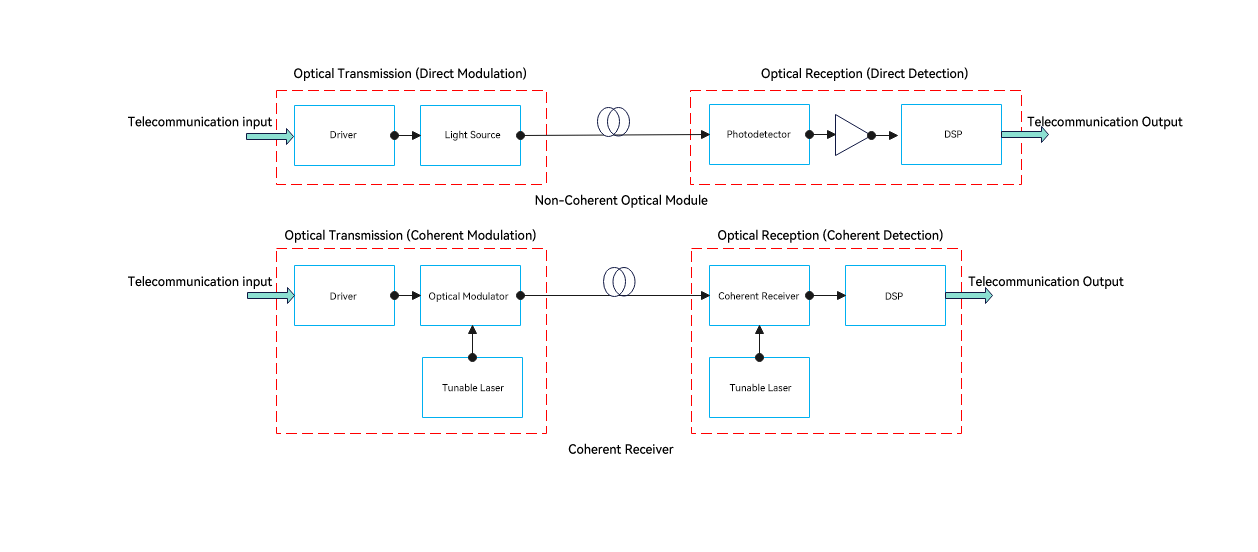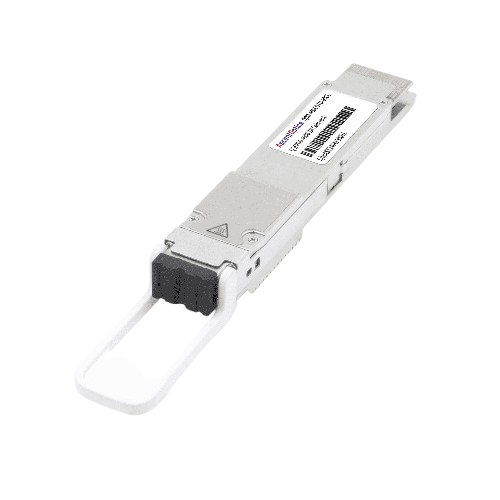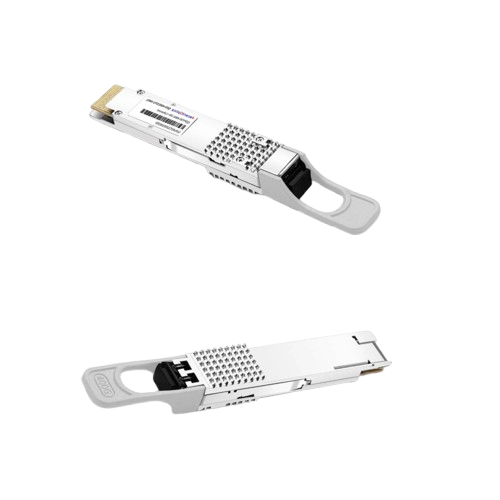The internet and data center boom has driven explosive growth in network traffic, putting immense pressure on optical networks.Traditional non-coherent optical modules, with their limited bandwidth and simple modulation, can no longer meet the demands of high-speed, long-distance, and high-density transmission. Advances in DSP and optical device manufacturing have enabled coherent optical modules to deliver higher speeds and longer distances, offering superior performance and broad application potential.
Optical modules are key components in fiber-optic systems, converting electrical signals to optical signals to overcome signal loss and interference in traditional cables, ensuring efficient long-haul transmission.
Coherent optical modules use coherent light (waves with fixed phase relationships) for signal transmission and processing, supporting advanced modulation and demodulation. They provide high signal-to-noise ratio and strong anti-interference capabilities, making them ideal for long-haul, high-capacity optical networks. While coherent modules are used in optical sensing and measurement, this article focuses on optical communications.

As shown in the diagram, coherent optical modules primarily consist of optical components and DSP components.
The optical components primarily include: ITLA (Integrated Tunable Laser Assembly), CDM (Coherent Driver Modulator), ICR (Integrated Coherent Receiver). The latter two (CDM & ICR) can also be integrated into a unified ICRM (Integrated Coherent Receiver Modulator). The coherent high-speed optical devices features Broad spectrum, low loss, high speed and high power, ensuring optimal coherent optical signal transmission and reception.
Tunable Laser: Typically employs a laser as the light source to generate high-intensity, monochromatic, and coherent laser beams for transmitting optical signals.
Coherent Driver Modulator: Modulates the optical signal by altering specific characteristics (e.g., amplitude, phase, or frequency) to transmit information.
Common Modulation Schemes Include: Amplitude Modulation,Phase Modulation,Polarization + Phase Modulation and Polarization + Phase + Amplitude Modulation.
Common coherent modulation techniques include QPSK (Quadrature Phase-Shift Keying) and 16QAM (16-ary Quadrature Amplitude Modulation).
Integrated Coherent Receiver (ICR): Demodulates received optical signals to recover original data while performing processing and amplification, with demodulation methods typically matching the corresponding modulation schemes.
DSP Component
Composed of analog IP (SERDES, AD/DA) and digital IP (coherent algorithms, forward error correction FEC, digital coherent modulation/demodulation), it performs high-speed digital signal processing—including encoding/decoding, clock recovery, and other functions to ensure reliable and precise high-speed data transmission—while eliminating interference from dispersion, noise, and nonlinear effects to reconstruct the original transmitted signal.
In addition to these core components, coherent optical modules incorporate other control circuits, advanced packaging, and thermal management designs to form a complete system. It is the continuous innovation and enhancement of these core technologies that enable higher-speed optical communication.
The application of optical modulation and demodulation technology represents the most fundamental distinction between coherent and non-coherent optical modules, as simply illustrated in the diagram below.

Differences Between Coherent and Non-Coherent Optical Modules:
Coherent Optical Modules:
Utilize coherent modulation (e.g., PSK, QPSK, QAM) and heterodyne detection. The receiver mixes the signal light with a local oscillator (LO) for high-sensitivity detection.
Rely on DSP to compensate for transmission impairments (e.g., chromatic dispersion, polarization-mode dispersion).
Non-Coherent Optical Modules:
Adopt IM-DD (Intensity Modulation-Direct Detection): Transmit signals via laser on/off states (0/1). The receiver directly detects light intensity changes.
Transmission Distance: Coherent optical modules support long-haul transmission over thousands of kilometers (e.g., 400G ZR reaching 120km) due to their high receiver sensitivity (approximately 20dB improvement) and DSP-based compensation capabilities, while non-coherent optical modules are typically limited to distances of just tens of kilometers.
Capacity and Spectral Efficiency: By employing advanced modulation schemes such as 16QAM and polarization multiplexing, coherent technology achieves single-wavelength transmission at 400G/800G rates with superior spectral efficiency. In contrast, non-coherent technology requires multiple parallel wavelengths (e.g., 4×100G) to achieve comparable throughput, resulting in significantly lower spectral efficiency.
This fundamental difference enables coherent systems to maximize fiber capacity while minimizing channel spacing requirements in dense wavelength-division multiplexing (DWDM) networks. The spectral efficiency advantage translates directly into greater total throughput per fiber and reduced operational costs for network operators deploying coherent solutions in backbone infrastructure.
Coherent modules offer superior adaptability through support for flexible grid allocation and rate programmability (e.g., dynamic switching between 200G/400G/800G configurations), whereas non-coherent modules operate at fixed data rates.

Coherent Modules optimized for long-haul, high-capacity applications including:
Their technical advantages become exponentially greater beyond 80 km distances, enabling record-breaking capacities like 20+Tbps per fiber in submarine cable systems.
Non-Coherent Modules dominate short-reach connectivity markets:
With simplified optoelectronic architectures, they achieve 60-70% cost reduction versus coherent alternatives at similar speeds, though limited to <10 km reaches. They maintain >90% market share in leaf-spine network architectures.
Coherent Modules exhibit higher system complexity due to their sophisticated components:
Narrow-linewidth lasers (typically <100 kHz), IQ modulators with precise phase control, High-performance DSP chips (e.g., 7nm process for 400G, consuming ~8W). This architecture results in 3-5× higher power consumption and 2-3× greater cost compared to non-coherent alternatives at equivalent data rates.
Non-Coherent Modules leverage simplified architectures: Directly modulated lasers (DMLs) or electro-absorption modulators (EAMs), Basic driver ICs without DSP requirements, Typical power consumption <3W for 400G variants (e.g., DR4). Their streamlined design achieves 60-70% cost savings for short-reach applications (<10 km).
Industry Tradeoff: While coherent solutions dominate beyond 80 km despite higher costs, non-coherent modules maintain ~80% market share in data center intra-connect scenarios due to their power/price advantages.
Coherent modules adhere to interoperability-focused industry standards:
OIF 400ZR: Pluggable coherent specification optimized for 400G DCI, supporting 80-120km reach
These standards emphasize multi-vendor compatibility for open optical network architectures.
Non-coherent modules comply with IEEE 802.3 Ethernet standards:
100GBASE-LR4: 100G specification for 10km single-mode fiber transmission
400GBASE-DR4: 500m short-reach multimode solution using 4×100G parallel architecture
Their standardization prioritizes plug-and-play interoperability in data center environments.
Key Differentiation:
Coherent standards (e.g., ZR/ZR+) optimize parameters for long-haul transmission, while non-coherent standards (BASE-xx) focus on cost efficiency for short-reach interconnects, reflecting distinct application requirements. OIF and IEEE are now collaborating on unified standards for higher rates.

The industry has transitioned from CFP2 to compact QSFP-DD/OSFP pluggable form factors, while reducing power consumption from >15W to <10W – achieving higher port density and energy efficiency for next-gen optical systems.
Hybrid Material Platforms : Combining Indium Phosphide (InP) lasers with silicon photonics to achieve monolithic integration of lasers, modulators, and detectors, significantly lowering cost and footprint.
Volume Manufacturing: Leveraging CMOS-compatible processes to scale production for datacom and telecom markets.
Higher-Order Formats: Adopting 64QAM(64-state Quadrature Amplitude Modulation) and Probabilistic Constellation Shaping (PCS) to increase single-wavelength rates to 1.2 Tbps.
Nonlinear Mitigation: Pairing PCS with machine learning-based DSP to combat fiber nonlinearities, extending reach for high-order modulation.
A representative example is the 400G QSFP-DD DCO (Digital Coherent Optics) module, which supports DP-16QAM modulation (Dual-Polarization 16-state Quadrature Amplitude Modulation) and oFEC (Open Forward Error Correction) technology. It is designed to meet the high-density and low-power consumption requirements of both data center interconnects (DCI) and telecom networks.
Driven by the growing demand for high-speed OTN transmission and the maturing optical module industry chain, coherent optical modules are now widely deployed across long-haul backbone, metro, access, and DCI networks. Currently, 100G, 200G, and 400G coherent optical modules have been put into large-scale commercial deployment, while industry players are actively exploring and advancing the practical application of 400G+ optical modules.
Coherent optical modules represent the inevitable evolution of fiber-optic communications toward higher speeds and longer distances, integrating breakthroughs in modulation technologies, DSP algorithms, and packaging processes. These advancements address the critical demands of modern networks for massive capacity and flexible network architectures, establishing coherent technology as the cornerstone of next-generation optical infrastructure.